Classification of epithelium:
Depending on the number of cell layers present, the covering epithelia are divided into the following two main types:
- Simple (or unilaminar) epithelia which consist of only a single layer of cells.
- Stratified (or multilaminar) epithelia which consist of two or more layers of epithelial cells.
SIMPLE(UNILAMINAR) EPITHELIA
A simple epithelium consists of only a single layer of cells, Each cell has a free surface and a basal surface which rests on the basement membrane. The lateral margins of the adjacent cells are closely apposed and are held together by cell junctions. Consequently, in a surface view the cells appear to form a mosaic. According to the shape of their component cells, the simple epithelia are further classified into the following four types:
i) Simple squamous epithelium which is composed of flat cells.
ii) Simple cuboidal epithelium consisting of cuboidal cells(cuboidal=cube-like).
iii) Simple columnar epithelium which consists of long, column-shaped cells,
iv) Pseudostratified Epithelium which really consistsm of a single layer of cell but gives a false appearance of being stratified.
Simple squamous epithelium
The simple squamous variety of epithelium consists of a single layer of thin flat cells which are roughly polygonal in outline. One surface (the basal surface) of each flat cell rests on the basement membrane, whereas the other surface (the free surface) faces a cavity or lumen of an organ. The cells have serrated or wavy margins and the adjacent cells fit closely together to form a continuous sheet. Each cell contains a flattened nucleus located in the centre of the cell.
Presence of the nucleus in the central region of the flat cell causes the plasma membranes above and below to bulge slightly., On surface view the closely fitting polygonal cells appear like tiles in a floor. Sections made perpendicular to the epithelial sheet show that in profile (I.e., in side view) the individual cells give fusiform(spindle-shaped) appearance because the central region of each cell is thicker (due to the presence of the nucleus), while peripherally the cytoplasm is very thin (having a thickness of 0.1 pm or less).
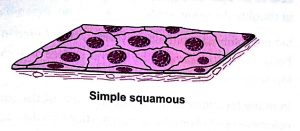
Simple squamous epithelium is of common occurrence in the body; chief examples are: (1) endothelium which covers the internal surface of heart, blood vessels and lymph vessels, (2) mesothelium which lines the pericardial, pleural and peritoneal cavities, and (3) the lining epithelium of the alveoli of the lung.
Because of its thinness, the simple squamous epithelium allows rapid diffusion of water and gases but in many locations it is also engaged in active transport.
SIMPLE CUBOIDAL EPITHELUM
This variety of epithelium also consists of a single layer of closely apposed cells. When seen in profile (e.g., sections made perpendicular to the epithelial sheet) the cells give a roughly square outline, the height and width of each cell appearing to be nearly equal. This appearance is the reason why this variety of epithelium was titled in earlier times as cuboidal epithelium. However, surface view of the epithelium reveals that the cells are rather hexagonal or polygonal in shape, the closely fitting cells appearing to form a mosaic. Each cell contains a spherical nucleus which is located in the centre of the cell.
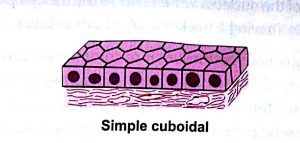
Simple cuboidal epithelium generally lines small excretory ducts of exocrine glands (e.g., intercalated ducts of salivary glands and pancreas), where it may perform the function of secretion and absorption. This variety of epithelium also lines the distal convoluted tubules of kidney, where it has an absorptive function. Simple cuboidal epithelium also covers the outer surface of the ovary. Respiratory bronchioles of the lung are also lined by simple cuboidal epithelium.
SIMPLE COLUMNAR EPITHELIUM
This type of epithelium consists of a single layer of columnar, I.e., column-shaped cells (column=tall, upright pillar). On surface view, the cells appear as a mosaic resembling that of simple cuboidal epithelium, but the outline of the cells is rather smaller. In perpendicular sections the columnar shape of the cells becomes evident, the height of each cell being greater than its width. The nucleus is commonly oval in shape and usually located near the base of the cell, The nuclei of the component cells of an epithelial sheet are often seen to be situated at roughly the same level.
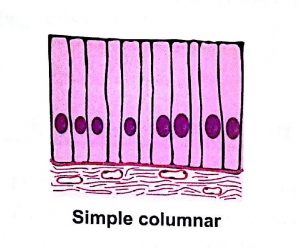
Simple columnar epithelium is widely distributed in the body. It lines, for example, the internal surface of stomach, intestines, gall bladder, and uterus.
In many locations in the body, the cells of the simple columnar epithelium show modifications on their apical surface, which includes microvilli, Kinocilia, and stereocilia
PSEUDOSTRATIFIED EPITHELIUM
This is a modification of simple columnar epithelium in which the nuclei of the cells lie at different levels, giving the epithelium a false appearance of being stratified. All cells rest on a basement membrane but all of them do not extend to the free surface. Those which extend through the entire thickness of the epithelium are tall columnar cells. These cells are widest near the free surface but basal part of each cell narrows to a slender process which passes downward to the basal lamina. A second variety of cells, called basal cells, are present between the columnar cells.
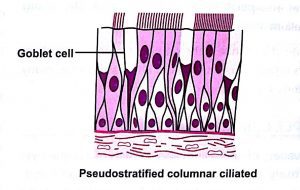
The basal cells are conical in shape having a broad base which rests on the basal lamina. Traced upwards, these cells taper rapidly and do not reach the free surface. Because the nuclei are present in the wider part of the cells of both types, they (I.e., nuclei) are found aligned at two or more levels in the epithelium, creating a false appearance of cell stratification in histological sections. Accordingly, the epithelium is named as pseudostratified columnar epithelium (pseudes is a Greek word meaning false).
The pseudostratified simple columnar epithelium lines the conducting part of the respiratory system (nose, nasopharynx, trachea, and bronchi). It also lines in the male genital ducts (duct of epididymis and ductus deferens). The tall cells of the pseudostratified epithelium usually exhibit modifications on their apical surface in the form of cilia or stereocilia.
STRATIFIED (MULTILAMINAR) EPITHELIUM
These epithelia consist of two or more layers of cells. Stratified epithelia are further classified into subtypes according to the shape of the cells in the superficial layer, i.e., the layer on the free surface of the epithelium. Thus, this group of epithelia has the following subtypes: stratified squamous epithelium, stratified cuboidal epithelium, and stratified columnar epithelium. A special type of multilaminar epithelia is called transitional epithelium.
STRATIFIED SQUAUOUS EPITHELIUM
This variety of epithelium lines those surfaces which are subjected to wear and tear. The number of layers in this type of epithelium varies considerably in different locations but the shape and arrangement of the cells are quite characteristic. The deepest or basal layer, which rests on a basement membrane, is formed by low columnar or cuboidal cells which steadily divide mitotically to provide a constant supply of cells for the overlying layers. Next to the basal layer are present a few layers of larger polygonal cells. As the free surface is approached, the cells gradually become flattened and at the surface they are squamous.
The condition of the cells of the most superficial layers of the stratified squamous epithelium varies with the location and environment of the ep thelium. Taking into account the state of the most superficial cells, two subvarieties of the stratified squamous epiihelium are recognized: keratinized (also called cornified) and non-keratinized (also called non-cornified).
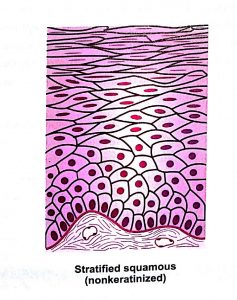
Over those surfaces which are subjected to abrasion an desiccation(drying), the cytoplasm ofthe superficial cells accumulates large numbers of keratin filaments. Near the surface of the epithelia the cells lose their nuclei and organelles and become converted into dead, flattened plates (squames) consisting of the protein kerotin. The intercellular space between the squamous cells contains a water proofing glycolipid. This subvariety is known as stratified squamous keratinized epithelium. The best example of the stratified squamous keratinized epithelium is the epidermis which covers the entire free surface of the body.
In the second variety of the squamous epithelium, the surface cells become very flat but mostly remain nucleated and their cytoplasm contains little or no keratin.
This subvariety is known as stratified squamous nonkeratinized epithelium. This variety of epithelium lines those surfaces in the body which are submitted to abrasion but remain wet and are not subjected to desiccation. The lining epithelia of most of the oral cavity, oropharynx, esophagus, and vagina belong to the stratified squamous nonkeratinized variety.
In both subtypes of the stratified squamous epithelium the most superficial cells constantly flake off from the surface, indicating the base to surface progress of the cells. As already noted, mitotic activity in the basal layer produces new cells which move into the overlying layers and become polygonal in shape. In the polygonal cell layers the cells still keep on moving toward the surface until they reach the most superficial layers where they assume a squamous shape. The most superficial squamous cells lose their desmosomes and flake off from the free surface.
STRATIFIED CUBOIDAL EPITHELIUM
The stratified cuboidal epithelium consists of two or three layers of cuboidal cells. This type of epithelium has a very restricted distribution in the human body. It only occurs as the lining of the larger ducts of some exocrine glands like pancreas and salivary glands, The ducts of the sweat glands are also lined by this type epithelium. The stratified cuboidal epithelium has not been found to be involvedin absorptive or secretory activity. Its probable function is to provide the ducts with a stronger lining than the simple cuboidal or simple columnar epithelium.
STRATIFIED COLUMNAR EPITHELIUM
This variety of stratified epithelium consists of columnar surface cells which rest on one or more layers of roughly cuboidal cells. This epithelium also has a restricted distribution in the body. The stratified columnar epithelium has been found to line some parts of the male urethra. The lining epithelium of the conjunctiva of eye is also a typical example of the stratified columnar epithelium.
Note: Unlike the stratified squamous epithelium, the surface cells of the stratified cuboidal and stratified columnar epithelia are not continuously replaced by basal mitosis and there is no progress from the base to surface.
TRANSITION EPITHELIUM (UROTELIUM)
The transitional epithelium is a special type of stratified epithelium that lines the urinary tract. This epithelium is specially designed to withstand stretch produced by distension of the urinary passages due to storing and passing of urine. The transitional epithelium is also specialized to prevent reabsorption of the urine (which is a toxic fluid). This special type of epithelium lines the renal calyces, renal pelvis, ureters, urinary bladder, and proximal parts of the male and female urethra. Because the transitional epithelium is found only in the urinary tract, it is also known as uroepithelium or urothelium.

The structure:
The structure of the transitional epithelium is best studied in sections of the wall of the urinary bladder. It is to be noted that the microscopic structure of this special type of multilaminar epithelium varies greatly according to the state of distension of the urinary bladder. In the undistended (I.e., contracted) urinary bladder, the urothelium appears to consist of 6 or 8 cell layers. The basal layer of the epithelium consists of cuboidal cells.
Over the basal layer are present several layers of polygonal cells. The most superficial layer of tt: e epithelium appears to consist of very large dome-shape cells whose highly convex apices bulge into the bladder cavity. Some of these cells contain two nuclei.
Distension of the urinary bladder stretches and flattens the epithelium. In the fully distended (I.e., stretched) state, the transitional epithelium is seen to consist of only 2 or 3 layers. There is a basal layer of low cuboidal cells over which are present one or two layers of large flat (squamous) cells.
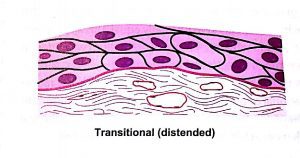
The change in number of layers indicates the ability of the cells of the transitional epithelium to accommodate to stretching. The cells in the basal layer are not much affected by the distension but the cells in the next three or four layers become flattened (instead of polygonal).
The large, highly convex surface cells not only flatten but also unfold their Iuminal plasma membranes to accommodate the increasing area. The folding an unfolding of plasma membranes covering the luminal surfaces of the most superficial cells of the urothelium occurs due to special structure of these membranes.
When a fully stretched transitional epithelium is studied under EM, the apical plasma lemma of the most superficial cells of the urothelium occurs due to special structure of these membranes.
When a fully stretched transitional epithelium is studied under EM, the apical plasma lemma of the most superficial by nervous or neuro hormonal signals. They are found around the secretory acini of the mammary, salivary, lacrimal and sweat glands. Their contraction assists in the flow of secretion into the larger channels.
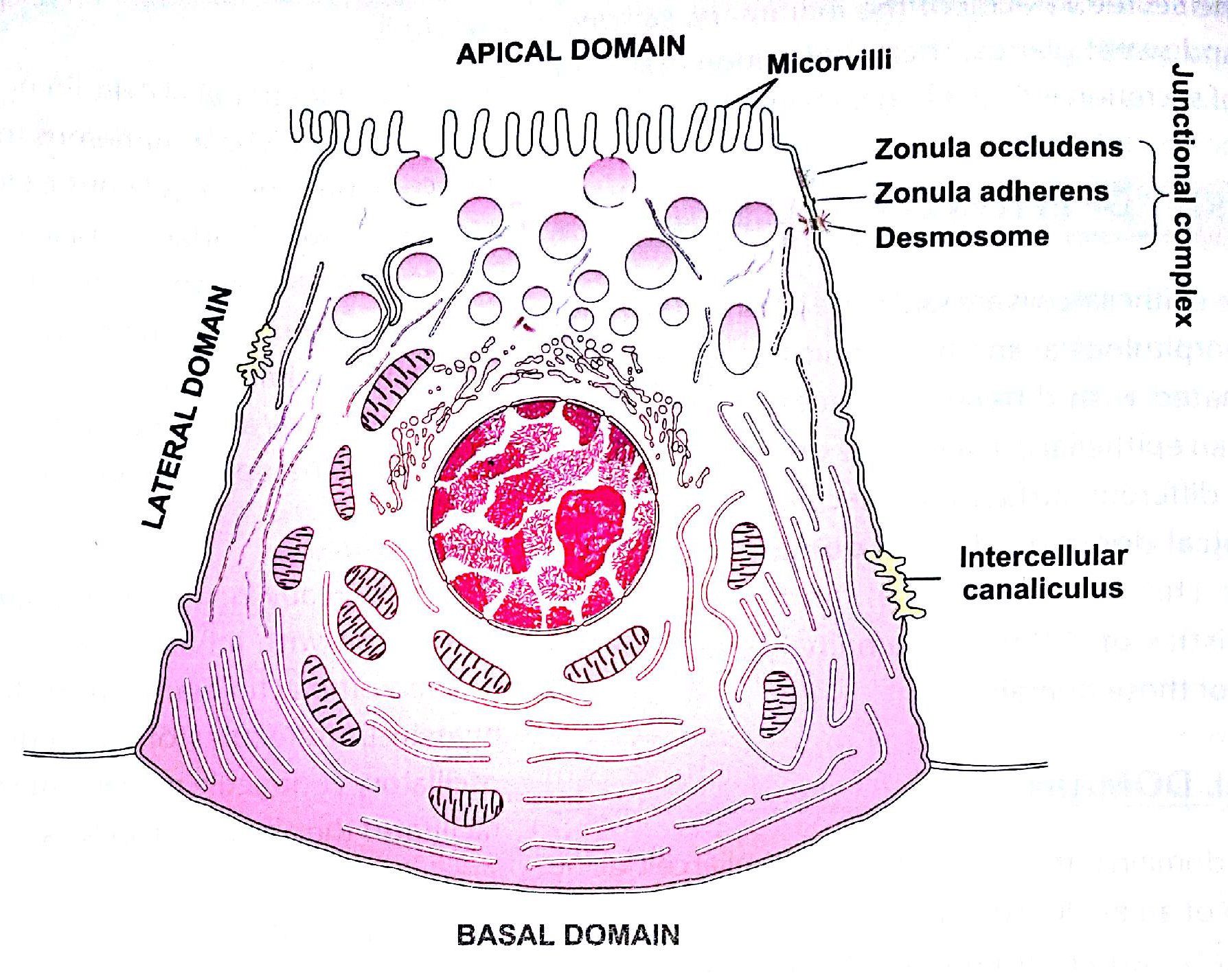
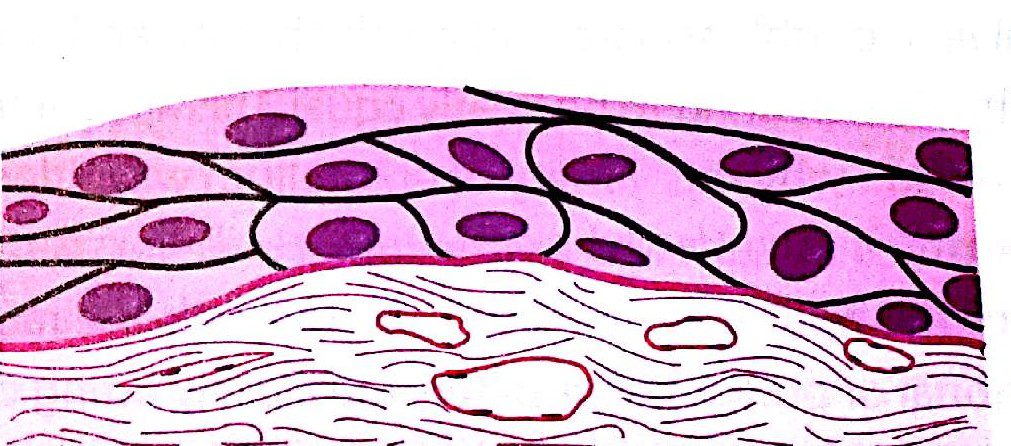

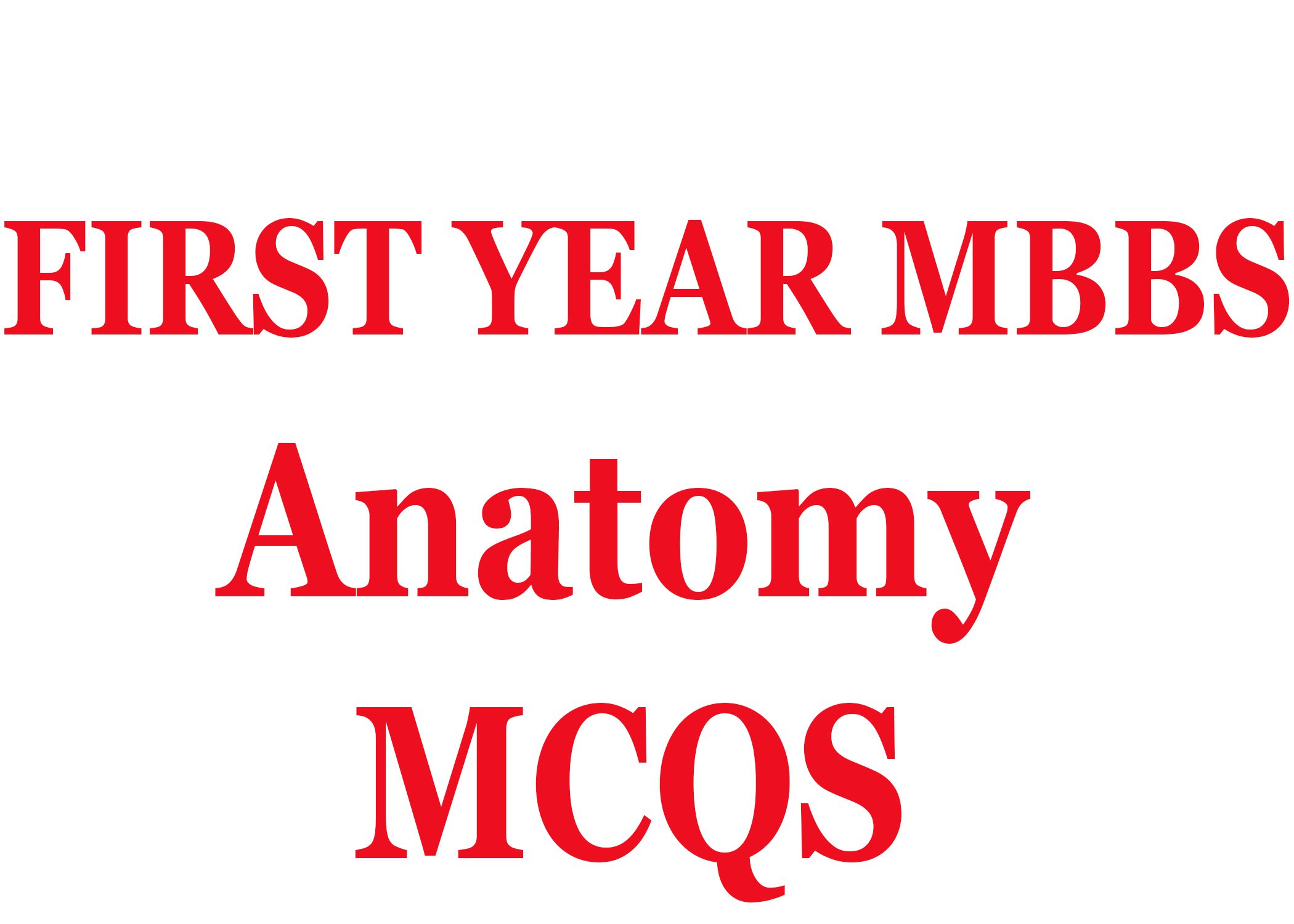




Leave a Reply